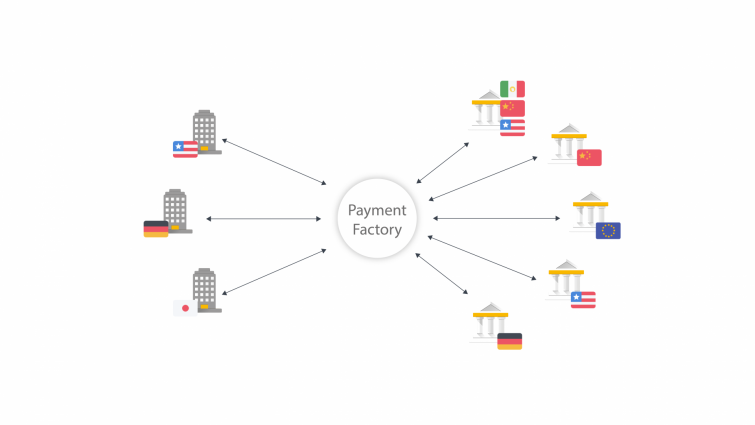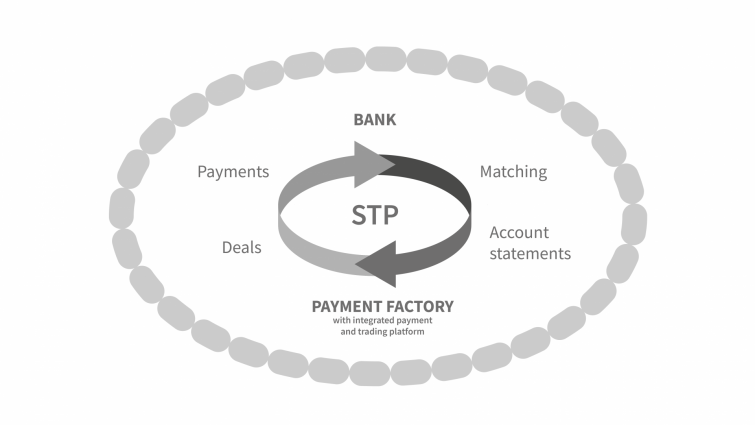Secure Payments with a Payment Factory

When it comes to payments, companies face a double-edged challenge: On one hand, they are expected to make their payment processes as efficient and inexpensive as possible. On the other hand, the onus is on them to introduce stringent security measures to prevent financial losses caused by fraud and cybercrime. A payment factory is an excellent solution that addresses both challenges. The winning combination: centralized and automated processes. By implementing a payment factory, companies create synergies that help future-proof their business.
Security through centralization
A payment factory streamlines a company’s entire payment process, with a central treasury department or service center at the head. This way treasury achieves full cash flow visibility. It has complete control of all payment-related processes.

This boost in visibility alone creates a situation where payment processing errors and fraud attempts can be detected and resolved quickly. In addition, all payment factory workflows can be integrated on a treasury management system (TMS) payments platform in a way that makes them tamper-proof.
The system defines:
- Who is authorized to enter and change master data
- Who is authorized to enter a payment transaction
- Who is authorized to approve a payment transaction
- In the system, you can also set limits, for example, based on organizational hierarchies, to strengthen payment security
A centralized database creates visibility and enables the treasury to monitor every cash flow. This is particularly relevant where significant aspects of the payment process have been automated.
Security through automation
With a payment factory, you can automate payment runs, which boosts efficiency. By automating processes you not only avoid errors caused by incorrect data entry or transfer, often associated with manual data entry. You also prevent manipulation and fraud as automated processes are closed-loop process chains that cannot be tampered with from the outside.

If you work with a TMS that has an integrated payment platform, you can process your payments directly in the system and automatically import account statements. Having an integrated trading platform enables you to process deals electronically and to match, report, and maintain them in the system. This is an efficient, manipulation and fraud-proof process.
Security through internal data quality
For automated data cycles to run smoothly, sets of data need to be communicated accurately between the different applications within a company and the banks’ systems. For companies, it is worth obtaining a modular system that is scalable. Based on a group-wide, fully integrated database, you can add new areas of responsibility step by step and involve subsidiaries – without having to overcome media breaks and having to synchronize data.
Blog: How to Optimize Treasury Data –Better data quality for better decision-making
Security through external data quality
In the interest of payment security, you need to keep an eye on external systems in addition to your own systems: the banks’ systems.
“Be particularly wary when processing payments outside of the standardized ISO 20022 payment landscape.”
To ensure seamless communication all the way from your systems to the banks, it is a good idea to reach out to your banking partners before you implement a payment factory. The essential question is: What sort of data quality does the banking partner require and what quality can they deliver? This is an analysis that is best conducted together with your system vendor if they have the expertise and offer consulting in addition to technology.
Security and intercompany transparency through automated reconciliation
Build your payment factory on the foundation of a multi-bank TMS. This way you cannot only automate payment processing, you can also check that everything has been processed correctly based on automatically imported account statements. Every matching account statement tells you that everything is in order. The system spots any transaction that cannot automatically be matched to a statement and requires further investigation. You achieve transparency.
You can easily identify the payment references communicated as part of a transaction by way of the file format. This way you can automatically connect a payment to a specific subsidiary, giving central treasury a clear overview of the payments landscape across the group.
Security through a banking strategy
Before you introduce a payment factory you need a suitable consolidation process for accounts and banking partners. Having fewer banking connections as well as approved, functional technical requirements for exact payment file formats means increased security.
When you review your banking partners, a strategic approach makes most sense. Make sure your banks’ offering aligns with the future requirements of your company. For example, does a potential partner also offer efficient services in the regions and countries you’re planning to expand to? This way, your payment factory project for a more secure payments setup even creates synergies that will help you future-proof your entire company.
All in all:
A payment factory paves the way for multiple optimized processes relevant to your company’s security. In addition, it significantly boosts security through automation, transparency, visibility and control. Our recommendation: Make sure you pay attention to the available data quality when selecting a banking partner. By doing so, you ensure seamless communication between your company’s systems and external data sources.
Want to learn more about our powerful treasury solutions? Time to discover Coupa Treasury.